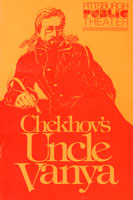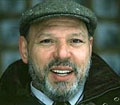
Second Season
September 29, 1976-January 23, 1977Season increased from Three Months to Four
Uncle Vanya
Directed by Shaktman
World premier of translation by Michael Henry Heim; designed by John Jensen bringing into the rectangular performing space both the inside and outside of Chekhov’s great Scenes from Country Life. Christopher Bernau, Vanya; Jack Ryland, Astrov; Veronica Castang, Sonya; William Roerick, Professor Serebryakov; Jenifer Henn, Yelena, his new wife; Joan Croyden, his first wife and Vanya’s mother; Michael Thompson, Telegin; Antoinette Kray, Marina. Perhaps proudest of this production than any before or after: everything fit perfectly. Just made for these actors who wore David Toser’s costumes as if they’d been wearing them for years. Exuberant. Funny. Heartbreaking. Thompson’s Telegin playing guitar and becoming carried away with songs created anew in Heim’s clever translation-adaptation of Russian lyrics. Vanya firing a pistol at the Professor who was standing a few feet away – and not coming at all close to hitting him. Could this missed-shot, after all an act of violence, create hilarity in the audience? At every performance. As created with great comic brio by the shooter, Chris Bernau and the target, Bill Roerick. How they transformed from total fright, then immense relief, followed by “uncontrollable” laughter and then fury! Vanya because he missed; Serebryakov because he was still alive. And yes heartbreak when Bernau and Castang holding each other at the play’s conclusion as Sonya speaks Chekhov’s brave concluding lines: “We will go on, Uncle Vanya. We will work. We will work through the years. And we will go on.”
Sizwe Bansi is Dead
Directed by Woodie King, Jr.
By Athol Fugard, John Kani and Winston Ntshona, with Joe Morton and Joe Seneca. Scenery and costumes by Karl Eigsti, lighting by Bennet Averyt. One of the joys of being an artistic director is to collaborate in my “own theater” with men and women I worked with before Pittsburgh. King was one of them. He was the most casually disciplined director I had seen. He laid claim to the brilliant success of this production when he managed to select Morton and Seneca. Virtuosos, they captured PPTs audiences to such an extent that had we had any flexibility in our schedule,  we could have extended this production by three weeks. Part of American playwriting history resulted from this production. Among our audience was August Wilson who lived in Pittsburgh and saw it several times. He said that it was Sizwe Banzi at PPT that inspired him to try to write plays. Try he certainly did! When August and I actually met for the first time in 1983, his recollection of what impressed him about the play and Woodie King’s production and how they related specifically to some of his own work couldn’t have been more gratifying. .
we could have extended this production by three weeks. Part of American playwriting history resulted from this production. Among our audience was August Wilson who lived in Pittsburgh and saw it several times. He said that it was Sizwe Banzi at PPT that inspired him to try to write plays. Try he certainly did! When August and I actually met for the first time in 1983, his recollection of what impressed him about the play and Woodie King’s production and how they related specifically to some of his own work couldn’t have been more gratifying. .
Henry 5
Directed by Shaktman
Shakespeare's flag-waving history play was performed here on one of the most ingenious and complicated of scenic constructions by Peter Wexler. Flat fighting fields became the Agincourt hills to climb, tents to shiver in, trenches where hand-to-hand combat was waged, royal throne rooms. No machinery at work in Wexler's scheme. Platforms, and bridges, raised and lowered by the actors. How? Still can't really figure it out. Featured were Lawrence Pressman, Henry; Jack Ryland, Chorus; Veronica Castang, Queen of France; Tom Carson, Pistol; Michael Thompson, Fluellen; John Grassilli, Bardolph; George Taylor, Nim; Robertson Carricart, Thomas Grey; Peter Murphy, Gower; Gisele Stephanopoli, Lady-in-waiting. Costumes by Whitney Blausen, lighting by Bennett Averyt.



